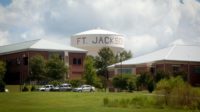...single soldiers are accommodating families, so we need to provide certain amenities,” Kuhn says. Playgrounds, child development centers and recreational facilities have become the norm at most installations.
As social needs have evolved, so has the Army’s emphasis on sustainability, Kuhn says. The Army has committed to a LEED-Silver rating for all new facilities. “The triple bottom line for Army sustainability is its focus on mission, community and environment and the inter-relationship between the three,” Kuhn says. “We’ve embraced sustainability and moved beyond sighting facilities on vacant land and lumping types together.”
Instead of bases that are laid out with separate areas for offices, housing, commissaries, recreation and other services, the trend is toward “creating communities with more of a hometown feel and accessibility to goods and services and recreation,” Kuhn says.
For example, Fort Belvoir in Virginia now includes five “villages” on the base, each with a community center that has retail development on the first floor and two-story apartments above. “The community center may have a coffee shop, dry cleaners, convenience store and welcome center,” Kuhn says.
Community centers are connected to individual residential housing, chapels, fitness centers and libraries by bike and walking paths and patched together with playgrounds and public green spaces. “It’s very similar to what you would see off base in a local neighborhood,” Kuhn says. In addition to promoting a sense of community, the plans reduce automobile use and foster healthier lifestyles, she adds. The concepts also are being applied to installations that don’t have massive construction under way. “We might provide linkages between facilities by creating sidewalks or bike paths or shuttle buses,” says Kuhn.
Warrior Support
One new facility type that reflects both soldier input as well as current circumstances are “Warriors in Transition” complexes, which will combine soldier-family assistance centers, American Disabilities Act-compliant barracks and administrative facilities in a campus-like setting, says Robert Moore Jr., spokesman for the U.S. Army Warrior Transition Command. He says the program means to reverse the decline, after the conflicts in Korea and Vietnam, of military convalescent facilities. The need for better services became apparent during the first Gulf War in 1990 and now during the prolonged deployments in Iraq and Afghanistan, with a significant increase in the number wounded, ill or injured soldiers who require long-term rehabilitation.
The program was defined in the 2007 Army Medical Action Plan, developed as part of the Army’s Warrior Care and Transition Program to transform patient care and support for soldiers and their families. The goal is to ensure the Army develops infrastructure necessary to care for soldiers and their families closer to their homes “to reduce the strain,” so they can concentrate on healing, Moore says.
In years past, severely injured soldiers were sent to Walter Reed Army Medical Center in Washington, D.C., often far away from family and friends.
The complexes “are a new breed of facilities within the military hierarchy of structures and facilities,” says Tom Mertz, vice president of the federal division of Sundt Construction Inc., Tempe, Ariz., which broke ground in September on the $30-million first phase of a $57-million complex at Fort Bliss, Texas. Seven more are either in design or construction in the U.S. out of a total of 21 the Army plans to build worldwide.






